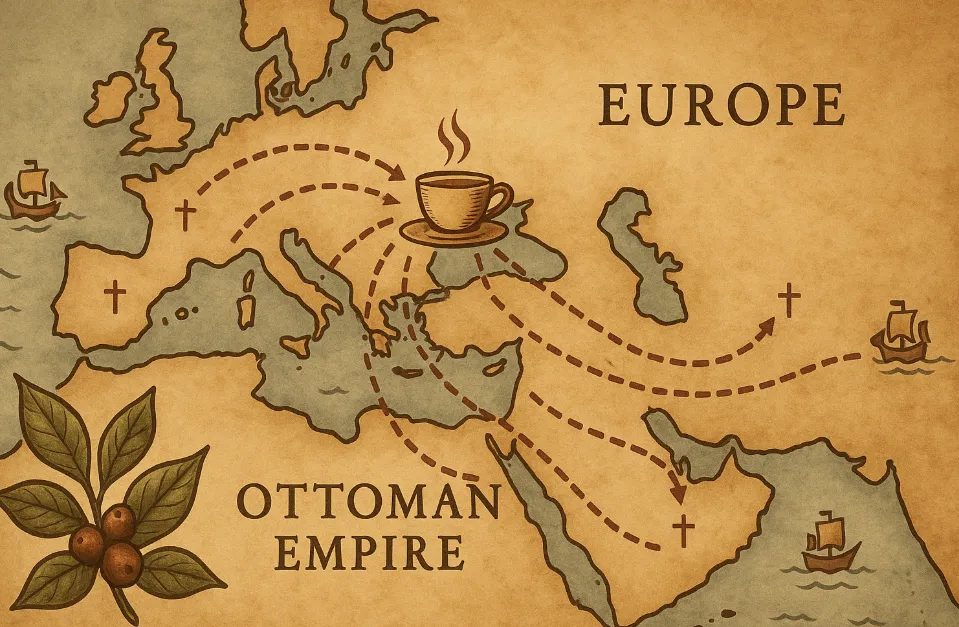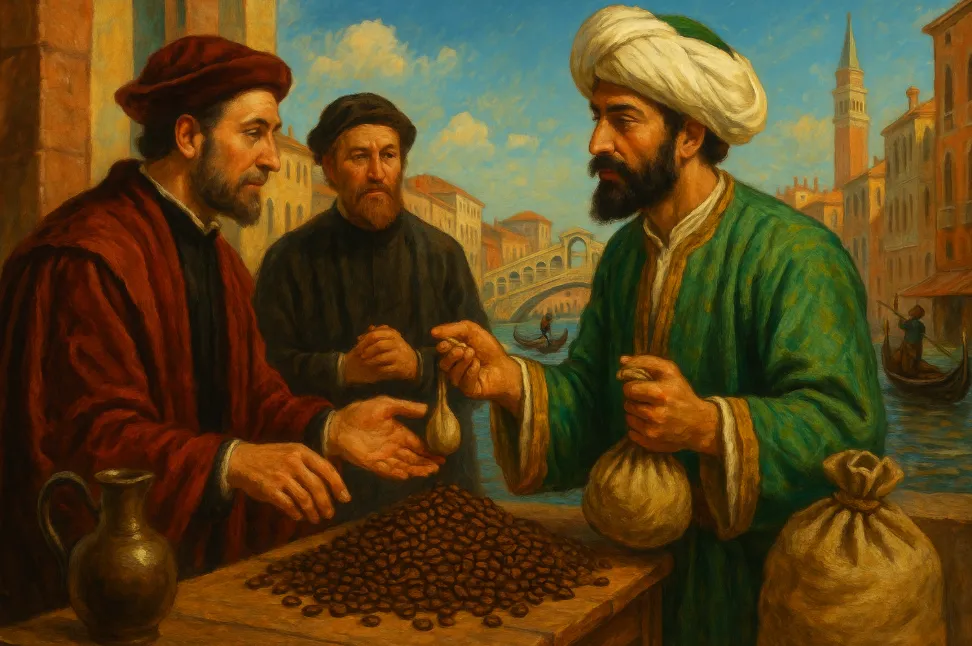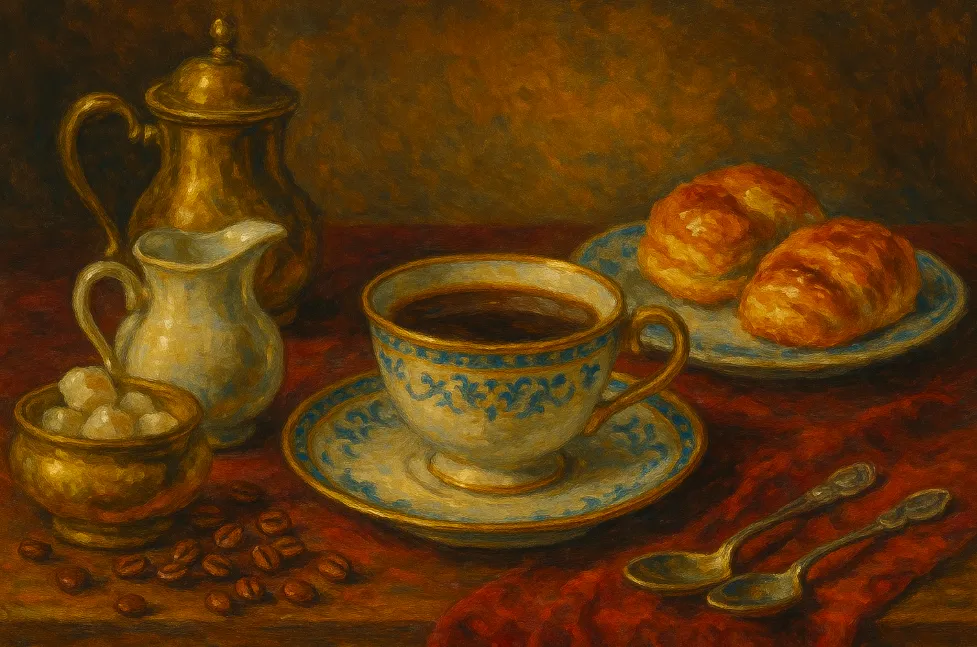Coffee's Journey to Europe: From Ottoman Trade Routes to European Coffee Culture
Discover how coffee spread from the Middle East to Europe through Ottoman trade routes, overcame religious resistance, and transformed European social life. Learn about coffee's cultural journey from 'Wine of Islam' to European coffee house revolution.
- Coffee Basics Nerds
- 6 min read

Coffee’s Epic Journey: From Ottoman Empire to European Coffee Revolution
The transformation of coffee from a beloved Middle Eastern beverage to a European coffee culture phenomenon represents one of history’s most fascinating cultural exchanges. This journey, spanning the 16th to 17th centuries, shows how coffee spread European-wide through trade, adaptation, and social innovation, ultimately reshaping European society itself.
After coffee’s legendary origins with Kaldi in Ethiopia and its refinement through traditional brewing methods, the beverage was ready for its next great adventure: conquering European hearts and minds.

The Ottoman Empire: Coffee’s Gateway to Europe
The coffee history timeline shows that the Ottoman Empire played the crucial role in coffee’s European introduction. By the 16th century, coffee had become deeply embedded in Ottoman culture, setting the stage for its westward journey.
Strategic Trade Route Control
- Vast network: Ottoman trade routes connected Asia, Africa, and Europe
- Cultural bridge: Empire served as conduit between Islamic and Christian worlds
- Coffee normalization: Beverage was already established in Ottoman daily life
- Merchant networks: Turkish and Arab traders familiar with coffee’s commercial potential
The Ottoman Empire’s strategic position made it the perfect launching point for coffee culture around the world expansion.
European Port Cities: Coffee’s First Footholds
Venice: The European Coffee Pioneer

Venice coffee history begins in the late 16th century when Venetian merchants, already experienced in luxury goods trade, encountered coffee through their Ottoman connections.
Why Venice Led the Way:
- Established trade relationships with Ottoman merchants
- Cosmopolitan atmosphere more accepting of foreign customs
- Wealthy merchant class willing to experiment with expensive imports
- Strategic Mediterranean location ideal for receiving Middle Eastern goods
Other European Entry Points
Marseille, France
- French merchants importing coffee via North African routes
- Integration with existing spice trade networks
London, England
- Coffee arriving through Levant Company connections
- Initially limited to wealthy merchant classes
Amsterdam, Netherlands
- Dutch traders recognizing coffee’s commercial potential
- Foundation for later colonial coffee cultivation
The “Wine of Islam”: European Religious Resistance
Coffee’s introduction to Europe wasn’t smooth. Many Europeans viewed coffee with suspicion, calling it the “Wine of Islam” and associating it with Muslim culture in an era of religious tension.
Religious and Cultural Opposition
- “Bitter invention of Satan”: Some Christian leaders denounced coffee
- Foreign suspicion: Association with Ottoman Empire created resistance
- Cultural conservatism: Europeans preferred traditional alcoholic beverages
- Economic concerns: Established wine and beer industries felt threatened
Overcoming Resistance
The european coffee culture transformation required coffee to prove its value:
- Papal approval: Pope Clement VIII allegedly blessed coffee, legitimizing it for Christians
- Economic benefits: Trade profits overcame cultural hesitation
- Social advantages: Coffee’s stimulating effects appealed to intellectuals and workers
- Gradual acceptance: Slow introduction allowed cultural adaptation
Cultural Adaptation: Europeanizing Coffee
Europeans didn’t simply adopt Middle Eastern coffee customs - they adapted coffee to suit european coffee culture preferences and social structures.

Key Adaptations
Flavor Modifications:
- Adding milk: Softened coffee’s bitter intensity for European palates
- Sugar incorporation: Made coffee more appealing to sweet-tooth Europeans
- Reduced spicing: Less emphasis on cardamom and other Middle Eastern spices
- Brewing adjustments: Lighter, less concentrated preparations
Social Adaptations:
- Gender inclusion: European coffee culture became more gender-inclusive than Middle Eastern traditions
- Business integration: Coffee became tool for commercial networking
- Intellectual emphasis: Focus on coffee as aid to thinking and discussion
- Daily routine integration: Coffee incorporated into European daily schedules
The Economic Revolution: Coffee Trade Networks
The coffee trade history in Europe created entirely new economic structures and relationships.
Commercial Development
Import Networks:
- Specialized coffee merchants emerged
- Insurance systems developed for coffee shipments
- Quality grading systems established
- Seasonal trading patterns developed
Price Accessibility:
- Initially luxury item for wealthy classes
- Gradual price reduction through increased supply
- Development of different quality grades for different markets
- Coffee becoming accessible to middle classes by late 17th century
Colonial Implications
European success with coffee imports led directly to colonial coffee cultivation:
- Dutch Java cultivation: Breaking Ottoman/Arabic monopoly
- French Caribbean plantations: Expanding supply sources
- Economic control: Europeans seeking to control entire coffee supply chain
- Foundation for colonialism: Coffee profits funding further colonial expansion
Social Transformation: Coffee Reshaping European Life
The coffee culture around the world expansion through Europe created unprecedented social changes.
New Social Spaces
Coffee’s European adoption led to the creation of coffee houses as social and intellectual hubs, fundamentally different from taverns:
- Sober socialization: Alternative to alcohol-centered gathering places
- Cross-class interaction: Coffee houses welcomed diverse social groups
- Information exchange: Centers for news, gossip, and business information
- Intellectual discourse: Fostering of philosophical and political discussion
Daily Life Changes
- Work productivity: Coffee enabling longer, more focused work periods
- Morning rituals: Coffee becoming part of daily startup routine
- Social customs: Coffee service becoming mark of hospitality
- Gender roles: Women’s involvement in coffee preparation and service
Regional European Variations
Different European regions developed distinct coffee culture characteristics:
Italy
- Espresso culture foundations: Focus on strong, quick coffee consumption
- Regional preparations: Different brewing methods across Italian states
- Social rituals: Coffee as daily social interaction
France
- Café culture: Coffee houses becoming centers of intellectual life
- Culinary integration: Coffee incorporated into French dining customs
- Colonial expansion: French coffee cultivation in Caribbean colonies
England
- Coffee house culture: “Penny universities” fostering intellectual exchange
- Business centers: Coffee houses becoming commercial meeting places
- Lloyd’s of London: Insurance market emerging from coffee house culture
Netherlands
- Colonial focus: Dutch prioritizing coffee cultivation over consumption culture
- Trade emphasis: Coffee as commercial commodity rather than social beverage
- Global networks: Dutch creating worldwide coffee trade systems
The Foundation for Modern Coffee Culture
This coffee history in europe period established patterns that continue today:
Lasting Impacts
- Social coffee consumption: Coffee as facilitator of human interaction
- Daily routine integration: Coffee as essential part of daily life
- Cultural adaptation: Local preferences shaping global beverage
- Economic importance: Coffee as significant trade commodity
- Innovation catalyst: Coffee spurring technological and social innovation
The European transformation of coffee from exotic Middle Eastern import to essential daily beverage demonstrates how cultural products evolve through geographic spread and local adaptation.
Coffee’s European Legacy
The coffee spread european phenomenon created the foundation for coffee’s eventual global dominance. European adaptation, trade networks, and cultural integration transformed coffee from regional beverage to international necessity.
This transformation also set the stage for later developments including colonial coffee production systems and the industrial revolution in coffee brewing.
Understanding how coffee conquered Europe helps explain modern coffee culture’s emphasis on social interaction, intellectual engagement, and daily ritual importance.
Continue exploring coffee’s fascinating journey with our guides to how coffee houses became intellectual centers and the role of colonialism in shaping coffee production.
You might also like:
- Tags:
- Coffee History in Europe
- Ottoman Empire Coffee
- Coffee Trade History
- European Coffee Culture
- Coffee Spread European
- Coffee Culture Around the World
- Venice Coffee History
- Coffee History Timeline
- Coffee Culture
- Coffee Brewing
- Coffee Production
- Brewing Methods
- Supply Chain
- Coffee Trade
- Coffee Supply
- Coffee Cultivation
- Modern Coffee
- Coffee Consumption
- Coffee Houses
- Coffee Service
- Middle Eastern
- Coffee History
- Coffee House
- Coffee Preparation
- Trade Relationships
- Traditional Brewing
- Coffee Fascinating
- House Culture